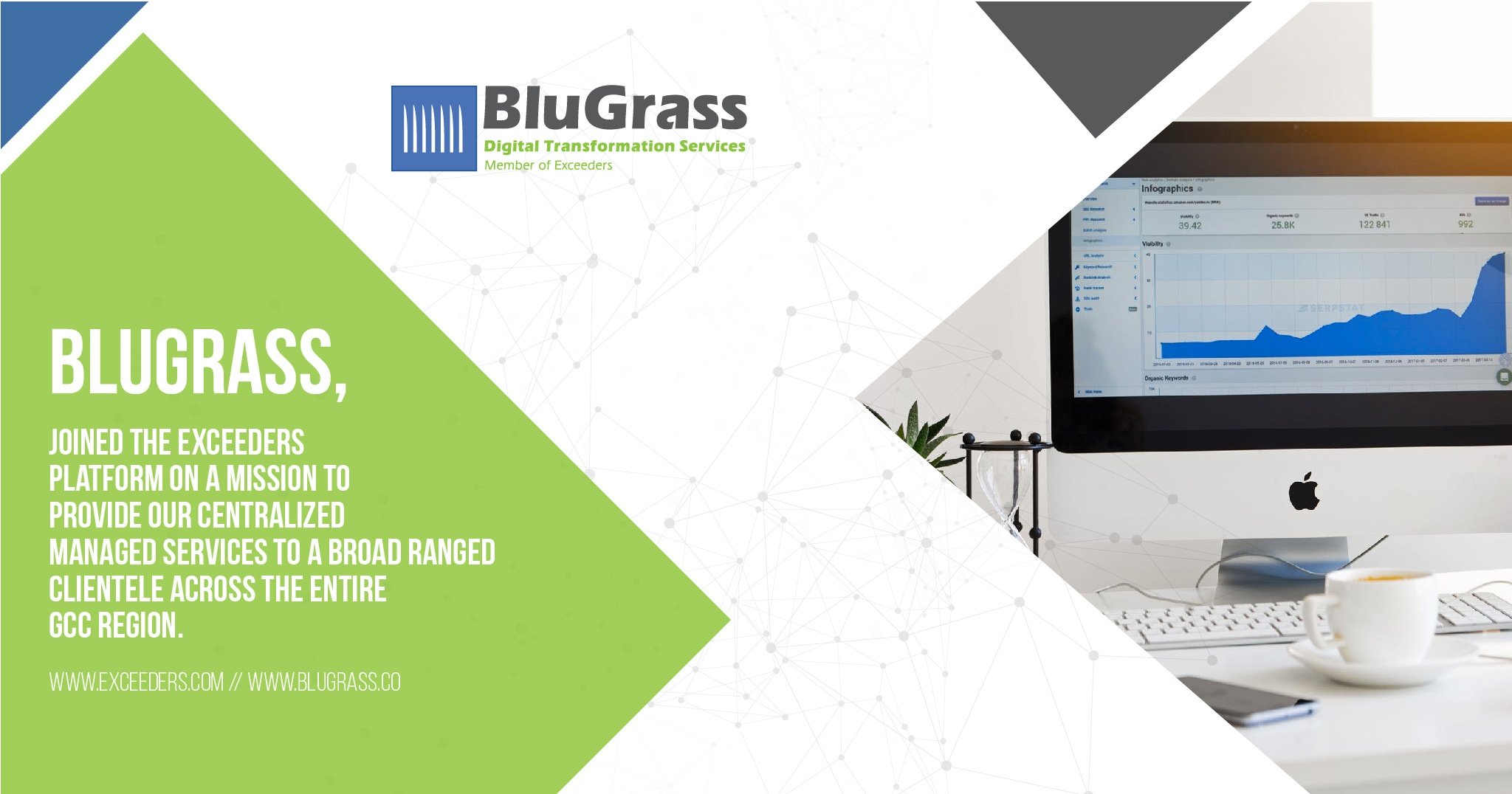
You see the end product but we’re bringing you closer to the people behind it !
As one of our most successful partners to date, we sat down with BluGrass’s co-founder Hasan Alameddine to gain firsthand insight on the things they do and the types of human capital profiles that drive their success.
Hasan has been in the IT industry for nine years with an education in Computer Science from the Lebanese American University in Beirut. He started as a CRM developer and was specialized in Microsoft products after he got his certification as a Microsoft Developer.

Hasan’s first enterprise experience in the UAE was as a CRM consultant in EMITAC, where he met Tony Alam and decided to jointly establish BluGrass.
Since its inception 4 years ago, BluGrass has grown to a team of 40 IT professionals with 32 customer success stories under their belt and 80M dirhams in revenue from managed services. Their primary market is the government sector with some focus on semi-government and private entities.
They first started providing hardware maintenance services but identified a gap in the market and quickly shifted their business model to that of a whole managed services provider where they do consultation, implementation, support, and resource allocation pertaining to specific projects.

What sets them apart from other service
providers in their field is their consultation phase. Rather than going straight into implementation based on a customer’s request, they allocation a major portion of the project to perform a full consultation that involves a gap analysis report.
This is to be able to identify all aspects in a customer’s current state, their desired state, and the required transition phase, and thus defining every parameter of the project to ensure complete visibility. After that phase has governed the customer’s approval, they will move into the implementation phase with full management and support from their side.
Since joining the Exceeders platform 2 years ago, they have been able to close 2 major deals in managed services.
![blugrass-smpost-02[8]](..\hs-fs\hubfs\blugrass-smpost-02[8].jpg?width=2048&name=blugrass-smpost-02%5B8%5D.jpg)
Success story
Recently, BluGrass signed a 5-year contract for a managed services project with a government-based investment company in the UAE. This entity collectively encompasses 6 other government agencies and an employee count that rakes up to 2000+.
The project entails managing the customer’s whole IT systems from bare infrastructure (servers, storage, networking) and security to infra applications (underlaying windows applications ) and high-level business applications (ERP, CRM).
Lorem ipsum dolor sit amet, consectetur adipiscing elit

Originally published Feb 22, 2020 9:45:00 AM, updated February 22, 2020
read
The Enterprise Digital Canvas is a comprehensive and structured blueprint of your Digital Enterprise. This article summarises learnings from effective Digital Workspace design for COVID-19 response, using the Digital Canvas model.
See how it works here:


Architecture Is The Foundation Digital Workspace
A successful workspace for recovery and growth requires you to have a 360-view of your operating capabilities. This is only possible by effectively leveraging The Digital Canvas (World’s leading framework for Digital Design).
For more information, visit our Partner Arqitek.
read
COVID-19 has become the most circulated word in 2020. This pandemic has already impacted the way organisations operate and will continue to fundamentally change them in the foreseeable future.
As this continues to impact our lives, remote working is our new reality. So, how do leaders, managers, & employees make this abrupt shift with minimal dips in efficiency?

Since we have been implementing remote working since 2014, we have come up with some guidelines on how you & your employees can effectively transition into remote working.
Any sudden change in the work environment is enough to disrupt operations if the business is not prepared or if it has not anticipated such a change. And this is exactly what is happening with most businesses today. In order to adjust to this new - hopefully temporary - “normal”, leaders should first prepare their employees mentally & should get the appropriate infrastructure to support remote working.
These are some of many things to consider during a transition like this.

We have listed below some pointers that have proven effective over our 6 years of implementing remote working:
Aside from the operational side of things, leaders must ensure that their employees are ready to handle their new lifestyle. COMMUNICATE. Have a group conversation with employees assuring them that there is certainty in the midst of all their uncertainty. Team members should constantly feel like they know what’s going on.
“This is a different time for us. We don’t know how long this will last but we are here to support each other and lift each other up. We will make sure you have what you need to continue your work as “normally” as possible.”
This type of assurance will help ease employees into this lifestyle and give them confidence that it will work. It is also imperative to set recurring meetings just so there is clarity on things and so the “teamwork” vibes are sustained. Frequency of contact should be maintained to keep the connections people had at the office.

It can be quite a shock to the human being to go from one way of life to another in a short period of time. Psychologically, employees need to be ready. That’s why it is advised to encourage employees to develop disciplined rituals so that they can stay on top of their tasks and remain productive:
As for infrastructure requirements, we compiled a list of the most crucial systems you need to thrive today.
read
Cloud computing is an exponentially growing market. According to a study by Forbes, the public cloud computing market, including cloud applications (SaaS), development and data platforms (PaaS), and infrastructure (IaaS) services combined is expected to grow to $299.4 billion.
With new businesses rapidly adopting cloud-based apps, these solutions have become mainstream in the industry as well as personal life. From our daily emails to phone storage, practically everything is stored and managed by cloud computing apps.
However, the uses of cloud computing are not just limited to personal emails or storage. With cloud computing services firms can avoid the upfront cost and complexity of owning and maintaining their own IT infrastructure, and instead simply pay for what they use, when they use it.

In the simplest terms, cloud computing means storing and accessing data and programs over the Internet instead of your computer's hard drive.
According to Microsoft,
“....cloud computing is the delivery of computing services—including servers, storage, databases, networking, software, analytics, and intelligence—over the Internet (“the cloud”) to offer faster innovation, flexible resources, and economies of scale. You typically pay only for cloud services you use, helping you lower your operating costs, run your infrastructure more efficiently, and scale as your business needs change...”
Let's see the top five ways business are using cloud computing in their day to day operations.
The cloud allows users to enjoy network-based access to communication tools like emails and calendars. Most of the messaging and calling apps like Skype and WhatsApp are also based on cloud infrastructure. All your messages and information are stored on the service provider’s hardware rather than on your personal device. This allows you access your information from anywhere via the internet.
VEGA Messenger and iDenedi are our very own communication app that allow remote teams to work and collaborate from anywhere in the world - in a very safe and secure way.
The modern computing power and capacity of the cloud lets businesses to store information about user behaviour. This can be used to develop customised solutions, messages and products based on the preferences of customers.
Siri, Alexa and Google Assistant - all are cloud-based natural-language intelligent bots. These chatbots leverage the computing capabilities of the cloud to provide personalised context-relevant customer experiences.
Read More: How AI is Helping Businesses improve Customer Experience
When organisations choose cloud for data storage the responsibility of their data also lies with the service provider. This saves business the cost of infrastructure and maintenance. The cloud service provider is responsible for securing data and meeting legal and compliance requirements.
The cloud also provides more flexibility in the sense that you can enjoy large storage and on-demand backups.

Recovery is also performed faster in the cloud because the data is stored over a network of physical servers rather than at one on-site data centre. Dropbox, Google Drive and Amazon S3 are popular examples of cloud backup solutions.
Read More: Check Out Our Managed Cyber Security Platform - ASPIDA
Whether a business develops application for web or mobile or even games, cloud computing services prove to be a reliable solution. Using the cloud, you can easily create scalable cross-platform experiences for your users.
Many of these services include many pre-coded tools and libraries — like directory services, search and security. Some will also offer full end to end service from strategy, consultancy, UX/UI, Development, QA and support. This can speed up and simplify the development process.
Learn More About Our Partner Knowarth and how they help enterprises build apps.

Many business management applications like customer relationship management (CRM) and enterprise resource planning (ERP) are also based on a cloud service provider. Software as a Service (SAAS) has become a popular method for deploying enterprise-level software.
It ensures hassle-free management, maintenance and security of your organisation’s critical business resources and allows you to access these applications conveniently via a web browser.
Here is a use case of our partner, iSystems

As a busy distributor, iSystem's client, Oxford University Press needed a sophisticated solution to optimise its distribution and customer service operations.
Dynamics 365 Finance and Operations is a cloud-based business application platform that combines components of customer relationship management (CRM) and enterprise resource planning (ERP), along with productivity applications and artificial intelligence tools.
iSystems supported Oxford University Press with a full integration between all the departments improved service by making current data available to all and streamlined order processing, saving OUP time and money.
Learn More About iSystems

Cloud computing services are still at a relatively early stage of adoption, despite their success stories. Many companies are still contemplating which apps to adopt and when.
However, their usage is only likely to go up as enterprises get more comfortable with the idea of their data being somewhere other than an expensive server in the basement.
COVID-19 has become the most circulated word in 2020. This pandemic has already impacted the way organisations operate and will continue to fundamentally change them in the foreseeable future.
Why Invest In Project Management Software?
What is it like to manage a project without proper communication? Sounds like a nightmare, isn't it?
